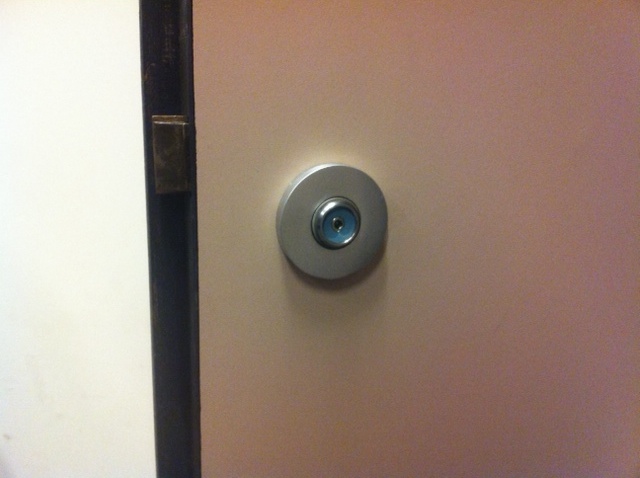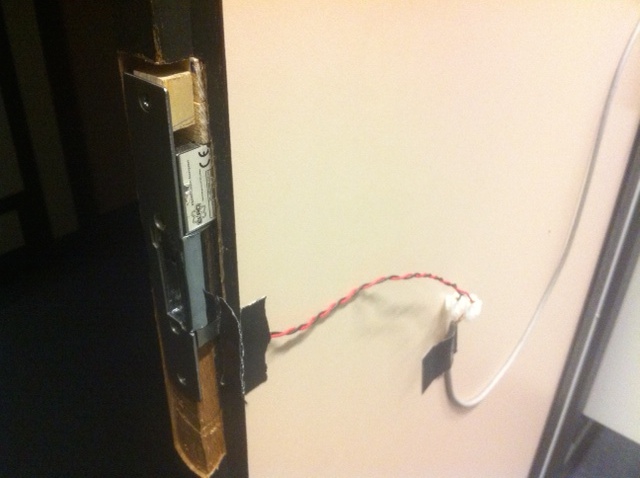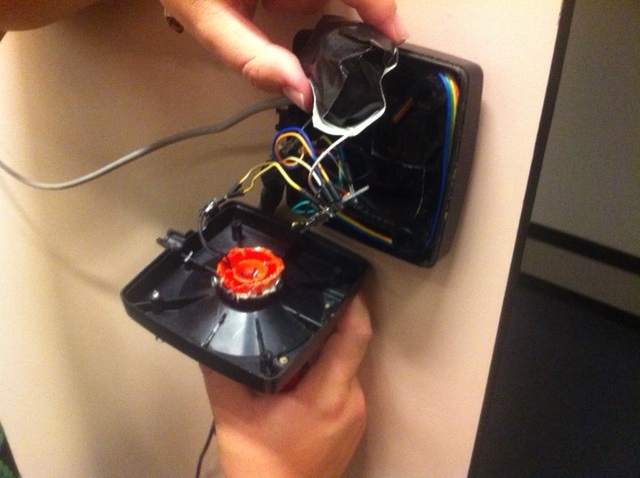ACKsess
Marked as outdated
This project has been decomissioned and superseeded by Acksess_2.0. It had a good ride.
| Project: ACKsess | |
|---|---|
| Featured: | No |
| State | Completed |
| Members | Vicarious, Prodigity, xopr, Stuiterveer, Jetse |
| GitHub | acksess |
| Description | Knock knock. |
| Picture | |

| |
Contents
[hide]synopsis
knock knock.
current implementation
The now working ACKsess implementation has several advantages over the old broken one, that broke.
- Heartbeat: it pulsates the LED every 5 seconds or so, to indicate it's active
- Better feedback (blink if door is unlocked)
- Brute force protection (locks 10 seconds after a failed authentication, pulsates very fast as a tamper indication)
- Faster response (shortened the delay for faster response)
- Opens on powerup/reset. This way, the reset button can be used to open the door
- Various code cleanup/alignment/update
- it beeps (as a helping aid)!
- it works stand-alone now together with an I2C display from xopr's project crate (serial still supported)
The door is connected to fuse group A.
mode of operation
- the door has 2 modes of operation: NORMAL and ADMIN (to be unlocked with a master key)
- once in ADMIN mode, there are two states: KEY set or unset
- ADMIN mode starts with no key set; also, long-press firebutton will unset a currently set key
- if no key is set, one can exit ADMIN mode by placing the master key
- one can set a key (for administration) by placing a new iButton, or (short) pressing the firebutton to cycle through the existing keys
- a set key can be deleted by placing the master key
| mode | iButton | firebutton | long press firebutton | master key | firebutton + master key | Note |
|---|---|---|---|---|---|---|
| NORMAL | open | open | open | open | go to ADMIN mode | display will show ACKsess granted!
|
| ADMIN | add+set KEY | set next KEY | unset KEY | exit ADMIN mode | display will show Program mode:add
| |
| KEY set | add+set KEY | set next KEY | unset KEY | delete KEY | display will show the key's ID or upon delete: Deleted @ <EEPROM index>
|
normal mode
- press the firebutton or put a valid key on the reader
- door will open
admin mode
- press and hold firebutton
- before the long beep ends, put a master key on the reader and hold both firmly
- an upward melody will play; release/remove buttons before it ends
- display will show
Program mode:add
exit admin mode
- put master button on the reader again
- a downward melody will play
add keys
- enter #admin mode
- put a new iButton on the reader
- a short high beep will sound upon adding
- display will show
Added @ <EEPROM index>and the key ID - press firebutton long (>1s) or the key will be deleted again
- exit by putting master button on the reader again
delete keys
- press firebutton shortly to cycle through the keys
- display will show
Program mode:deland the key ID - put master key on the reader to confirm and go back to admin mode
- a low beep will sound upon deletion
- display will show
Deleted @ <EEPROM index>
exit delete keys without deleting keys
- to go to admin mode without deleting keys: press firebutton long (>1s)
images
Some images
hardware
The joystick contains a print that fits snugly, with an Arduino pro mini. The print has print connectors, so everything can pop off easy. You can use an FTDI USB to serial adapter (115200 baud) or the dedicated I2C LCD for debugging and key management.
Joystick PCB
The PCB receives power, and uses a 7805 to power the Arduino.
Arduino pins
- 2: reader pin: reader 'data' pin, 4k7 pull up to 5v
- 3: led pin: uses pwm heart beat every 5 seconds and blinks fast if the door is unlocked
- 4: button pin: for use for external opener, pullup (connect to ground to trigger)
- 5: relay pin: set high to pull relay pin to low
- 9: buzzer pin: for audio feedback
- The NPN transistor used is a BC548 (goes up to 500mA), drived with a 100-300 something ohm resistor on the base (from the top of my head).
- Note that is has a diode (1n4000 something) antiparallel between collector and emittor as coil reverse voltage protection
- The onewire pull up used is 4k7 to 5v
DS9092L iButton probe
I had to reverse engineer the wiring somewhat (connector was gone), but here it is: DS9092L iButton probe datasheet Pinout:
- GND (blue)
- Data (onewire) (green)
- LED cathode (-) (yellow)
- LED anode (+) (orange)
software
Most of ACKsess.ino (old code):
#include <OneWire.h>
const int relayPin = 5; // the number of the relay pin
const int ledPin = 3; // the number of the LED pin (change to 13 to see the onboard led)
const int readerPin = 2; // the number of the iButton reader pin
const int buttonPin = 4; // the number of the pushbutton pin
const int buzzerPin = 9; // the number of the buzzer pin
OneWire ds( readerPin );
byte addr[ 8 ];
String keyStatus = "";
byte allowedButtons[][6] = {
/* ADD YOUR BUTTONS TO AUTHORIZE HERE */
};
byte disallowedButtons[][6] = {
/* ADD THE BUTTONS TO IGNORE HERE */
};
void setup(void)
{
Serial.begin(115200);
pinMode( buttonPin, INPUT_PULLUP );
pinMode( ledPin, OUTPUT );
pinMode( relayPin, OUTPUT );
Serial.println( "ACKsess initialized" );
Serial.print( "number of keys: " );
Serial.println( sizeof( allowedButtons ) / 6 );
// Open the door upon power up and (on board) reset
openDoor( true );
}
byte nState = 0;
byte nLedVal = 0;
bool bTamper = false;
void loop(void)
{
switch ( nState )
{
case 0: // forward, led fade in
nLedVal++;
if ( nLedVal >= 255 )
nState++;
if ( bTamper )
analogWrite( ledPin, nLedVal & 32 );
else
analogWrite( ledPin, nLedVal );
delay( 1 );
break;
case 1: // backward, led fade out
nLedVal--;
if ( nLedVal <= 0 )
nState++;
if ( bTamper )
analogWrite( ledPin, nLedVal & 32 );
else
analogWrite( ledPin, nLedVal );
delay( 1 );
break;
default: // idle
nState++;
delay( 500 );
if ( nState >= 10 )
nState = 0;
break;
};
// If the external button was pushed, open the door
if ( digitalRead( buttonPin ) == LOW )
openDoor( true );
// Check keys twice each fade and on every idle state step
if ( (nLedVal == 127) || ( nState > 1 ) )
{
// Store the button info and read the keycode
getKeyCode( );
if( keyStatus == "ok" )
{
// We have a correct key type, authenticate it
Serial.print("00");
for( byte i = 5; i > 0; i--)
{
Serial.print( ":" );
Serial.print(addr[i], HEX);
}
Serial.println( "" );
// Either open the door, or lock the system for 30 seconds
if ( authenticateKey( addr, false ) )
{
bTamper = false;
openDoor( false );
}
else if ( !authenticateKey( addr, true ) )
{
bTamper = true;
Serial.println( "ACKsess denied!" );
tone( buzzerPin, 600, 3000 );
delay( 30000 );
}
else
{
Serial.println( "ACKsess filtered" );
tone( buzzerPin, 600, 500 );
delay( 1000 );
tone( buzzerPin, 600, 500 );
delay( 1000 );
tone( buzzerPin, 600, 1000 );
}
}
}
}
void openDoor( bool _buttonPressed )
{
Serial.println( "ACKsess granted!" );
// Trigger the relay
digitalWrite( relayPin, HIGH );
// Blink the led fast for about 3 seconds
for ( byte n = 0; n < 3; n++ ) // 250+250*6 500+500*3
{
digitalWrite( ledPin, HIGH );
tone( buzzerPin, 1000, 250 );
delay( 250 );
digitalWrite( ledPin, LOW );
delay( 250 );
}
// Relay off
digitalWrite( relayPin, LOW );
}
void getKeyCode()
{
byte present = 0;
byte data[ 12 ];
keyStatus="";
if ( !ds.search( addr ) )
{
ds.reset_search( );
return;
}
if ( OneWire::crc8( addr, 7) != addr[ 7 ] )
{
keyStatus = "CRC invalid";
return;
}
keyStatus = "ok";
ds.reset( );
}
boolean authenticateKey( byte* _button, bool _includeIgnore )
{
/* SECURITY THROUGH OBSCURITY, VISIT US TO SEE SOME EXAMPLES */
return false;
}
todo
- redundant power supply (in case of power failure)
- adding a battery (implement stand-by mode, might need a refit of the pull-up)
- power on LED indicator (for detecting power loss separate from tamper)
- audit the authentication method (micros() and/or clock drift seed)
- add TVS diode (reader: yellow, GND: blue, VCC: orange-next-to-blue)
- allow admin access only if they are in EEPROM (but still allow key management)
- upload source to git
- add capacitive touch on the handle (grab & pull to open)
Location: hACKspace (You've passed it on the way in)




